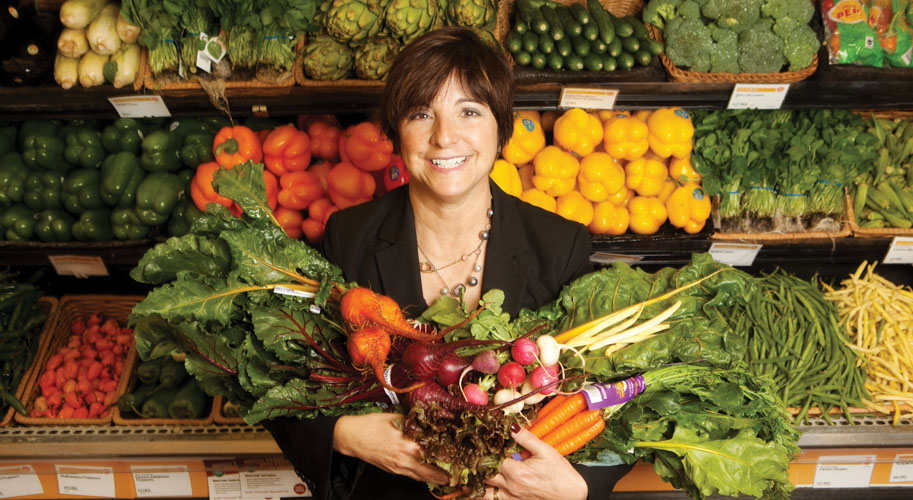Food as Medicine
 |
| Cynthia Thomson, PhD, RD, CSO |
The most effective cancer prevention therapy can’t be found in a miracle pill or through an expensive series of medical procedures. Cynthia Thomson, PhD, RD, CSO, said the best treatment can be found in the produce section of your local supermarket.
“Many of the compounds and bioactive chemicals that occur naturally in vegetables and fruit act to protect us against cancer,” Dr. Thomson said. “Many of the medicines we use to treat people are derived from these foods.”
Dr. Thomson is a professor of public health and director of the Canyon Ranch Center for Prevention and Health Promotion (CRCPHP) at the University of Arizona’s Mel and Enid Zuckerman College of Public Health. She has been an active researcher and clinician at The University of Arizona since 1992 and a University of Arizona Cancer Center member since 2000.
Dr. Thomson has more than 30 years of clinical and research experience in diet, obesity and cancer. She is a nationally recognized expert in the area of diet and health, having served as a national spokesperson for the American Dietetic Association, and she co-authored the American Cancer Society’s consumer book for diet, physical activity and cancer prevention guidance for survivors of cancer.
She has led several dietary intervention trials and directed the graduate program at the Department of Nutritional Sciences in the UA College of Agriculture and Life Sciences. These experiences make her uniquely positioned to improve the health of the public through effective and strategic research, interventions, community engagement, outreach and new, innovative training programs.
And, in perhaps her most impressive achievement, she came up with a plan to convince her two sons to make healthful eating a lifelong routine.
In the mid 1990s, Dr. Thomson embarked on “The Year of Fruits and Vegetables” with her boys, Daniel and Patrick. When the Thomsons would shop for groceries, she asked her sons to pick out a fruit or vegetable none of them had ever tried before. Eventually, this adventure led the Thomsons to Asian markets, farmers’ markets, and even to Willcox to visit the independent farms.
“We would always find a new treat or some new way to prepare an old stand-by,” Dr. Thomson said. “It was a lot of fun. The boys were old enough to get involved, but not quite old enough to have their eating habits set in stone.”
Today, Dr. Thomson’s sons have carried those healthful eating lessons into their early-to-mid 20s.
“People have these horrible memories of vegetables they tried to eat when they were young kids and they never try again,” Dr. Thomson said. “Healthy eating can be challenging if you hang on to old preferences. It’s about being creative and finding new ways to enrich your diet.”
A good rule of thumb is to make sure one-third of your shopping cart is filled with fruits and vegetables. Color variance is important, as well. This is an easy way to make sure your body is getting all of the nutrients essential for cancer prevention.
“The biochemicals present in vegetables and fruit can act as a small, low dose of medication,” Dr. Thomson said. “If you get that dose every single day of your life, it’s going to help protect you. Hopefully, you won’t have to take that large dose through pharmaceuticals later in life.”
Dr. Thomson added that it is important that consumers get in the habit of reading food labels and knowing what those numbers mean. Just because a food is marketed as healthy doesn’t mean that it necessarily delivers on that promise.
“For example, we’ve found that green tea has many positive health benefits, including a reduction in cancer risk for certain people,” Dr. Thomson said. “But now, you see it bottled up with dozens of other flavors and sweeteners. We had this healthy product that has now been diluted to the point where the beneficial compounds in some products have been minimized.”
Some people might not see this as such a big deal. After all, a diet low in essential nutrients can be fixed by a multivitamin regimen, right?
Well, not quite.
“What we’ve been able to ascertain through our studies is that multivitamin use is typically a marker of other good health habits,” Dr. Thomson said. “Those people who take multivitamins tend to be the people who are also eating balanced diets, reading labels, not smoking and receiving regular health screenings.” In addition, multivitamins do not contain the important, naturally occurring bioactive compounds found in vegetables and fruit.
So now you’re eating a healthful diet and you know what foods to avoid. What else can you do to minimize your cancer risk?
For starters, increase your physical activity. Most people mistakenly believe that a few minutes of serious exercise per day is enough, but that’s only the beginning.
“What we’re now realizing is that even people who exercise for 30 minutes several times a week may sit at their televisions and computers for hours at a time without moving. That is a major health risk,” Dr. Thomson said. “I set the alarm on my phone to remind me to get up and move every hour if I’ve been at my desk for too long.”
There are no quick-fix solutions to improve one’s health and reduce one’s risk for cancer. Consistency is the key. It comes from a daily diet rich in vegetables and fruit. It comes from regular physical activity. It comes from a healthy body weight. And it comes from creativity.
“I’d hate to one day live in a world like The Jetsons, where all your nourishment comes in pill form,” Dr. Thomson said. “With the internet, anyone can find fun, innovative and simple ways to prepare healthy foods.”
By Nick Prevenas. Reprinted with permission from the University of Arizona Cancer Center's Act Against Cancer, Winter 2012 issue.

